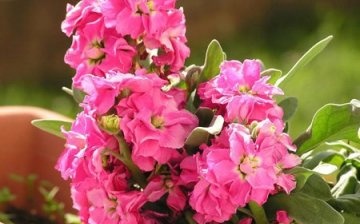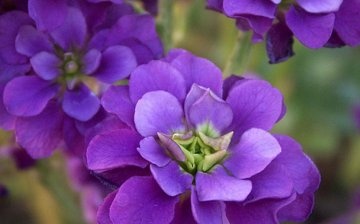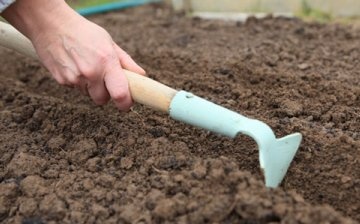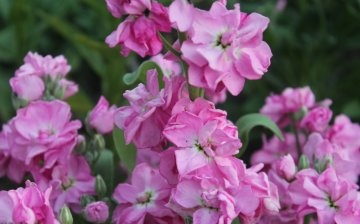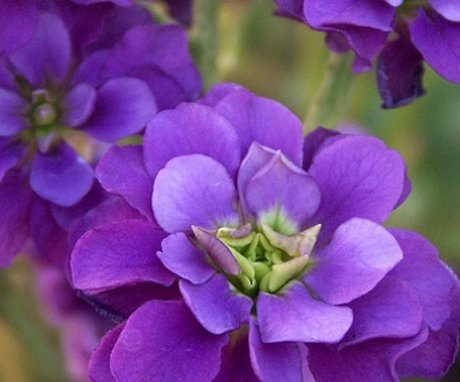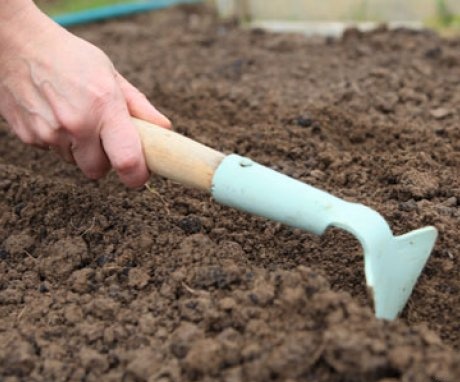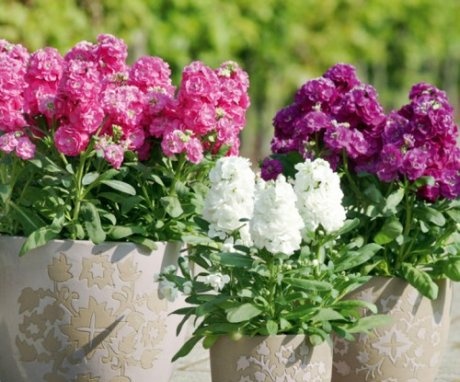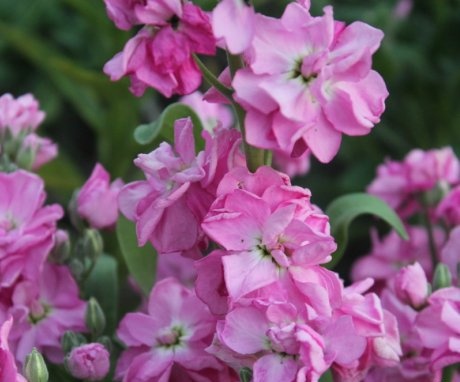Levkoy: growing from seeds and basic rules for flower care
Levkoy (or mattiola) is a beautiful, vibrant ornamental plant that used to be seen in every garden or park. But now it is possible to meet levka much less often, it is replaced by other flowering plants.
Levkoy will become a real decoration of the front garden or garden plot, it is an excellent choice for lovers of noble classics and fragrant flowers with a touch of antiquity. Growing Levkoy does not require much effort, and the beautiful view and exquisite aroma will delight you for a long time.
Content:
- Description of Levkoy
- Soil preparation, seed preparation and planting
- Growing conditions and care tips
- Diseases and pests of levkoy
Description of Levkoy
The main task matthiola - decorate the garden and delight with an enchanting aroma. At the moment, no special beneficial properties and use in medicine of this flower have been identified. Levkoy is an annual plant with double or smooth flowers. Terry inflorescences bloom longer, but seeds can only be harvested from smooth ones. Depending on the variety, levkoy reaches a height of 30-80 cm. The leaves are oblong, gray-green.
Depending on the duration of flowering, this plant is subdivided into summer, winter and autumn matthiola:
- Summer has the greatest number of shades: from white to red and purple. This is the most common variety. It blooms most of the summer (from June to August).
- Winter levkoy is planted in summer, and it begins to bloom only next spring.
- Autumn Levkoy is sown in spring, and it blooms in early autumn.
For connoisseurs of this plant, it will be easy to grow levkoy, growing from seed not the most time-consuming process, and in leaving the levkoy is not too whimsical. Most often, mattiola is planted next to benches, gazebos and balconies so that you can relax in the evenings and enjoy its aroma. This plant is also suitable for flower beds, lawns and even bouquets.
Mattiola got its name from the Italian physician and botanist Pietro Mattioli, who lived in the 16th century. The second name "levkoy" is translated as white violet... Greece and Asia Minor are considered the birthplace of Levkoy. Levkoe is mentioned in various sources, which suggests that it was actively cultivated in the gardens of Ancient Greece. These flowers were used to decorate bowls for wine and statues in temples. This is not so much connected with the beauty of the flower as with its wondrous scent. In some sources, the smell of levkoy is indicated as stuffy, dense. In the 16th century, a terry flower variety was bred. From the 18th century, new varieties began to be bred.
Levkoy can differ not only in the color and height of the flower, but also in the shape of the inflorescence.
For example, bouquet matthiola has denser inflorescences. These are compact flowers that look very beautiful and organic in bouquets. Bomb-like inflorescences have 1 central large inflorescence, which blooms before the lateral ones. Treelike levkoi are suitable for group planting in a flower bed, since they have rather large inflorescences. Levkoy outwardly does not have any catchy elements, it looks quite simple, but at the same time beautiful and sophisticated.
Soil preparation, seed preparation and planting
Landing Levkoev has its own characteristics. You can plant plants right away in open ground, if the varieties are early, but it is advisable to grow low-growing varieties of Mattiola in the form seedlings, and then already planted in open ground.
Planting Levkoy is a simple process, but it is important to follow all the rules so that you can then admire these flowers all summer.
Reproduction of Levkoy is possible only seedscollected from smooth varieties. However, these seeds can result in a double seed variety. Plants can be distinguished even at the seedling stage. In terry levkoy, the leaves are more gray, and in smooth ones, they are bright green. This difference will allow the gardener to correctly form flower beds.
Matthiola has seeds in small pods that can be easily confused with stems. When the pods begin to dry out, they are plucked and then shelled. There is another way to collect seeds. A blown bag, for example, made of nylon, is put on a bunch of pods so that they do not shed after the rain. Mattiola seeds can be planted every month, then the flower bed will bloom and smell until the frost. You can store the seeds until next spring, and then re-grow the seedlings or plant them directly in the open ground.
Growing rules:
- Summer matthiols should not be planted in soil where there are organic fertilizers... Usually fertilizers are applied at planting, but it is better not to do this with levkoy.
- You should not plant Matthiola where other cruciferous plants have grown for several years.
- To the seeds Levkoy germinated better, they are placed in water for a day and allowed to swell, after which the water is drained, the seeds themselves are wrapped in a damp cloth or gauze and placed in the refrigerator.
- Sow seeds for seedlings needed in late March or early April. In open ground, seeds are planted only after the soil has warmed up enough.
- You need to sow seeds in boxes with turf soil and sand. It is undesirable to sow seeds densely, their germination is good. Planting depth - no more than half a centimeter. Sprinkle the seeds with the same mixture and cover with foil.
- If you observe the temperature when growing seedlings (not higher than 22 degrees, not lower than 20), the first sprouts will hatch on the fourth day.
- When the first shoots appeared from the ground, the film must be removed and the supply of oxygen to the seedlings must be provided. The light with the poet must be diffused, and the temperature must be lowered to 10 degrees.
- It is not recommended to leave seedlings in one box before planting. As soon as the seedlings grow up, they need to be planted in separate pots. This should be done no later than 2 weeks after the emergence of sprouts, even if the leaves have not yet appeared.
- No drainage required. It will not harm, but there will not be much benefit from it. Levkoi can be planted simply in small holes.
- Even if you want to make a thick flower bed, do not plant levkoi too close to each other. Most varieties have very dense foliage, the roots and stems will rot, a fungal infection will appear, which can destroy the entire flower bed.
- Despite the fact that matthiols love the sun, they need to be planted in the evening or on a cloudy day, water immediately after planting.
- Before planting in the ground, green the plants a little. First open the vents in the room, and then take them out for a short while outside.
Growing conditions and care tips
After the seedlings are planted or the seeds are planted in open ground and begin to hatch, a period of active care begins. If you follow all the simple care rules, you can achieve a luxurious, densely blooming flower bed that will bloom and smell sweet all summer.
With proper care, levkoy blooms in a month or two after planting.
Conditions for growing Levkoy:
- Levkoy loves moisture, but not excess of it. It is equally bad for both dryness and waterlogging. Water it sufficiently and regularly, but not too abundantly. In hot weather, the leaves of the plant will curl up from lack of moisture. To avoid this, watering Matthiola must be directly under the root and preferably in the morning, before the onset of extreme heat.
- The soil in the flowerbed must be weeded and loosened regularly. You need to do this after glazeso that water penetrates well to the roots, the roots are saturated with oxygen, and dense crusts do not form on the soil surface.
- It is better to choose fertile soil for planting matthiola. On acidic soils, it will bloom poorly.
- During landing fertilizers do not apply, but it is necessary to feed the plant before flowering, however, it is better to choose inorganic fertilizers, mineral, in time flowering - potassium-phosphorus.
- The growing area must be well lit, then bloom will be especially lush. In shaded areas, levkoi are stretched out and bloom poorly. But it is advisable to protect the flower bed from a strong arid wind.
- To flower bed had a constantly fresh, blooming appearance, it is necessary to remove wilted flowers from the inflorescences. This will give the flower bed well-groomed, and the plant - more strength for further flowering.
- Do not fertilize matthiola with fresh manure. She can get sick and die.
- It is necessary to remove faded flowers from terry mattiola, since there will still be no fruit from them. If you left some flowers for cultivation seeds, you need to pinch the plant, then the seeds will ripen faster.
- It is advisable to change the place for planting Levkoi annually, and plant in their previous place petunias... After 3 years, you can again return to planting matthiol in the same place. Before planting, it is advisable to fertilize the soil with wood ash, then terry levkoi will be especially lush.
Diseases and pests of levkoy
Mattiola can be attacked by various pests and disease. Flowers should be regularly examined for disease and infected flowers should be removed in time.
With excessive moisture in the soil or air, matthiols are affected by the keel of cruciferous plants. It is because of this infection that Levkoi cannot be planted in the place where cruciferous plants have already grown before it. The fungus can live in soil for many years. Treating the plants themselves is most often useless. It is necessary to remove damaged flowers, and then spray soil with special compounds. This disease affects the plant through the root, therefore, it is outwardly difficult to immediately determine its signs. Deformed growths form on the roots and stem, the leaves turn yellow and wither.
If there is too little moisture, the weather is dry and there is insufficient moisture, Matthiola can infect cruciferous fleas.
Holes will appear on the leaves, by which you can identify the pest. To get rid of flea beetles, sprinkle the leaves and soil with wood ash. Do not be afraid of an unaesthetic look. At the very first precipitation, the ash will be washed away, and fleas will no longer appear after this procedure.
From waterlogging and improper care, Matthiola can hurt a black leg. In this case, the stem, and then the leaves, darken and die. The plant cannot be cured of this disease; it should be removed as soon as possible. For prophylaxis, before planting, you can treat the site drug Hom, it will reduce the risk of blackleg.
More information can be found in the video.



